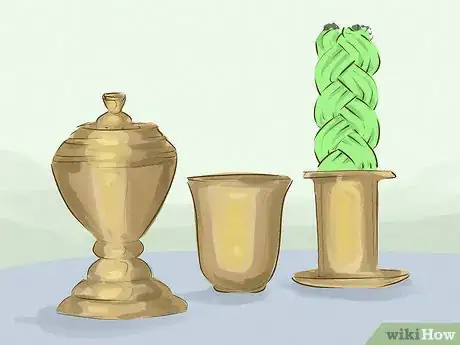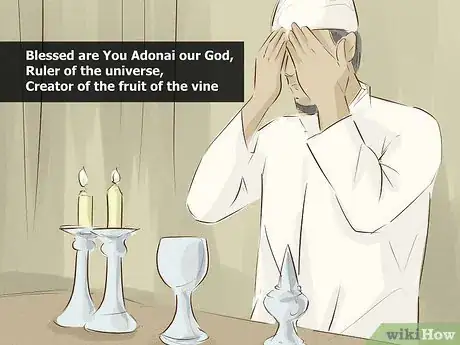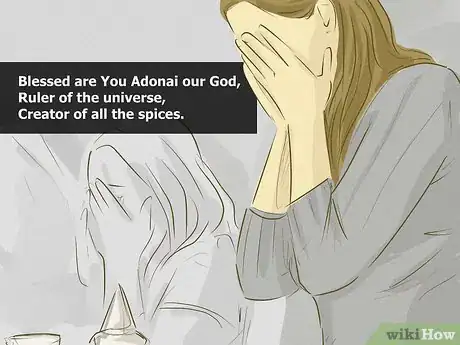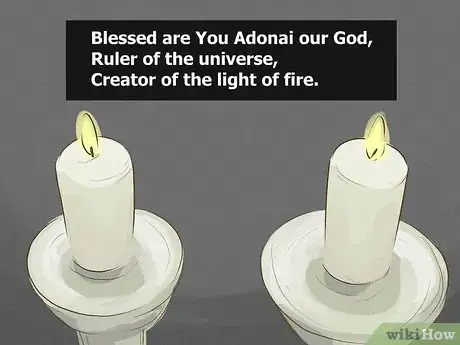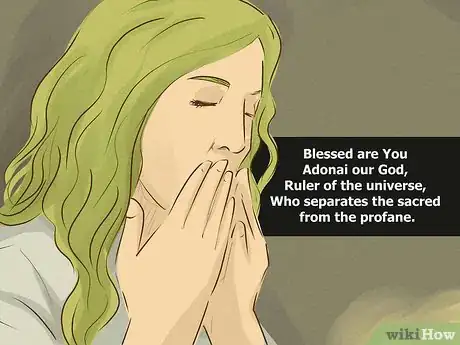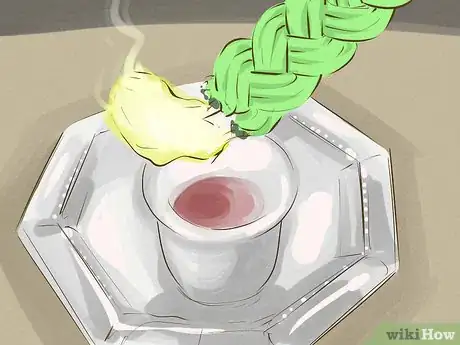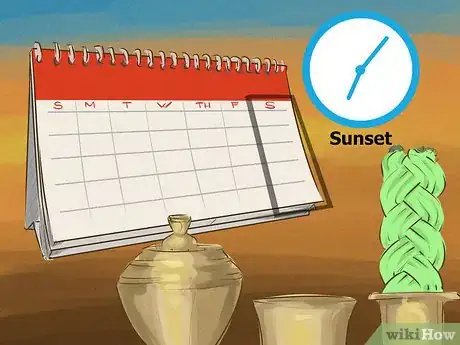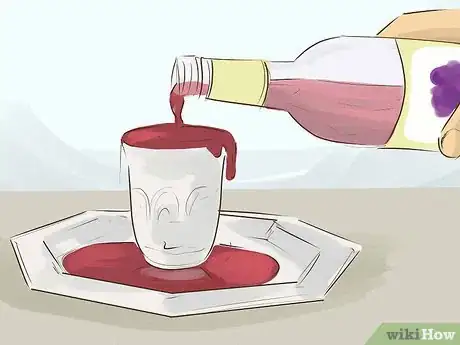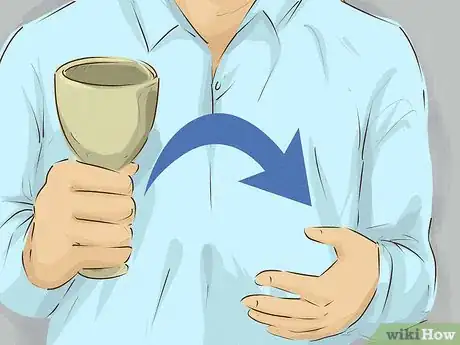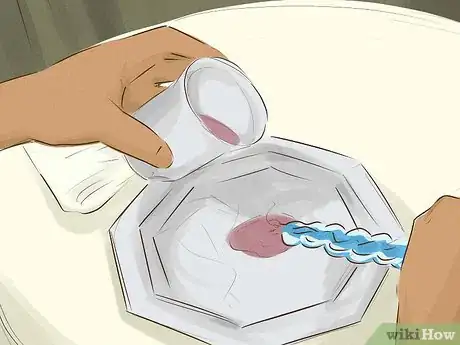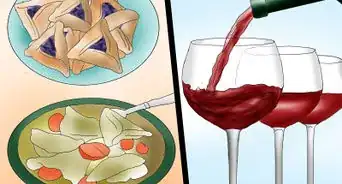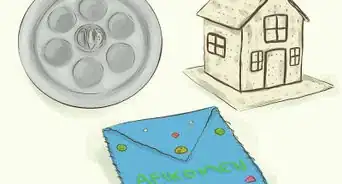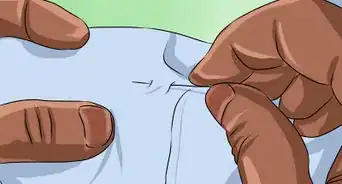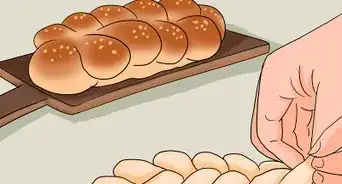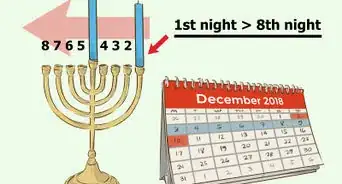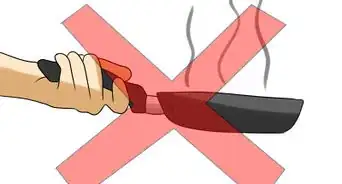This article was co-authored by wikiHow staff writer, Christopher M. Osborne, PhD. Christopher Osborne has been a wikiHow Content Creator since 2015. He is also a historian who holds a PhD from The University of Notre Dame and has taught at universities in and around Pittsburgh, PA. His scholarly publications and presentations focus on his research interests in early American history, but Chris also enjoys the challenges and rewards of writing wikiHow articles on a wide range of subjects.
This article has been viewed 21,345 times.
Learn more...
Havdalah (Hebrew: "separation") is the Jewish ceremony that marks the end of Shabbat, the Jewish day of rest, and in turn welcomes the new week. Performed after sundown each Saturday, its rituals are meant to stimulate the senses and spur you to look both back and ahead. It is a time to reflect on what made Shabbat special, and to think of loved ones if they are not able to be with you.
Steps
Performing the Essential Ceremony
-
1Prepare the ceremonial candle, wine, and spices. Start by lighting the Havdalah candle, which is typically braided and has several wicks. A wine glass is filled, and a spice box is filled (typically with cloves or cinnamon).
- The ceremony begins by making fire, which represents civilization, hope, and a way to overcome the darkness (both literal and figurative). Lighting the candle harkens back to Adam and Eve, who were afraid of the darkness until G-d showed them how to make fire.
- Even when the candle is put out, the memory of its warmth and light will remain.
-
2Recite the prayer over the wine. Wine represents hope and joy for a happy week ahead. Pray the following: ברוך אתה יי אלוהינו מלך העולם בורא פרי הגפן
- The transliteration is: Baruch ata Adonai eloheynu melech ha’olam borei p’ri hagafen.
- Translate this as: Blessed are You Adonai our God, Ruler of the universe, Creator of the fruit of the vine.
Advertisement -
3Recite the prayer over the spices: ברוך אתה יי אלהינו מלך העולם בורא מיני בשמים
- Transliterate the prayer this way: Baruch ata Adonai eloheynu melech ha’olam Borei miney b’samim.
- The English translation is: Blessed are You Adonai our God, Ruler of the universe, Creator of all the spices.
- The spice box can then be passed around. It symbolizes a revival of the senses, to remind you that the next Shabbat is only six days away.
-
4Recite the prayer over the candle/light. You can extend your hands towards the flame to feel its heat and appreciate its beauty while praying: ברוך אתה יי אלהינו מלך העולם בורא מאורי האש
- You can speak this transliteration: Baruch ata Adonai eloheynu melech ha’olam Borei m’orei ha-eish.
- The prayer translates as: Blessed are You Adonai our God, Ruler of the universe, Creator of the light of fire.
-
5Recite the concluding prayer. This blessing both closes the ceremony and points toward the new week that has just begun: ברוך אתה יי אלהינו מלך העולם המבדיל בין קדש לחול
- In transliteration, it is: Baruch ata Adonai eloheynu melech ha’olam Hamavdil bein kodesh l’chol.
- In translation, the prayer is: Blessed are You Adonai our God, Ruler of the universe, Who separates the sacred from the profane.
-
6Extinguish the Havdalah candle to begin the new week. The candle is put out in the wine and leaves you in (relative) darkness. Shabbat has ended, and it is time to look forward to the new week and what it holds in store. This last sound (the sizzle of the snuffed flame) is what separates the holy (Shabbat) from the mundane (the rest of the week).[1]
Adding Details, Options, and Traditions
-
1Start Havdalah after sunset on Saturday. The service should not begin before sundown, and the traditional timing is to wait until three medium sized stars can be viewed in a single glance at the sky.[2] There are, however, other means of determining when to start:
- Some people start Havdalah one hour and ten minutes later than they began Shabbat. So, if Shabbat began at 6:00 PM on Friday, Havdalah would begin at 7:10 PM on Saturday.
- Others base the start time on sunset in their location, and add approximately forty-five minutes. So, if that day’s recognized sunset time is 7:13 PM, Havdalah would begin just before 8:00 PM.
- There are online and printed guides available to help you time out when to begin Havdalah. You can also ask around regarding the traditional start time determination where you live.
-
2Overpour the wine, and bless yourself with it. Many celebrants choose to pour just a bit more wine than the cup or glass can hold, allowing some to spill over onto a plate positioned underneath. This is meant to represent the hope for an overflow of blessings in the week ahead.[3]
- At the conclusion of the Havdalah service, some people dip their pinky fingers into the spilled wine on the plate and rub their eyebrows and/or ears with it. This indicates a hope to see and hear good things in the coming week.
-
3Pick up and pass around the key items. While it is traditional to hold up the wine, spices, and candle at various times during the Havdalah service, the fine details tend to vary. Here is one version to consider following (it assumes a right-handed person; reverse the hand directions if you are a lefty):[4]
- Pick up the wine in your right hand; pray; move the wine to your left hand and continue to hold it.
- Pick up the spices in your right hand; pray; smell the spices and pass them around for others to do the same.
- Bless the candle while another holds it or, if alone, while it rests in a holder. During the blessing, all present can extend their hands toward the candle so that their fingernails reflect its light.
- Move the wine back to your right hand for the final blessing.
-
4Decide how to phrase the prayers. As with most elements of Havdalah, variations exist in the specific phrasing of the blessings given. You may wish to consult your local community regarding common phrasing and content. Here, for example, is a more detailed version of the final blessing:
- Barukh atah Adonai, Eloheinu, melekh ha'olam
- Blessed are you, Lord, our God, sovereign of the universe
- hamav'dil bein kodesh l'chol
- Who separates between sacred and secular
- bein or l'choshekh bein Yis'ra'eil la'amim
- between light and darkness, between Israel and the nations
- bein yom hash'vi'i l'sheishet y'mei hama'aseh
- between the seventh day and the six days of labor
- Barukh atah Adonai
- Blessed are You, Lord
- hamav'dil bein kodesh l'chol (Amein).
- who separates between sacred and secular. (Amen)
- Barukh atah Adonai, Eloheinu, melekh ha'olam
-
5Use the blessed wine to extinguish the blessed candle. After the Havdalah candle has been blessed and the service completed, the candle is extinguished. Many people choose to use the blessed wine to do this. For instance:[5]
- After the final prayer, the leader of the service drinks some of the wine.
- The rest of the wine is poured into a dish or bowl.
- The lit candle is dipped into the poured out wine.
- Alternatively, the candle flame can be held over the empty dish, and the wine poured onto it.
